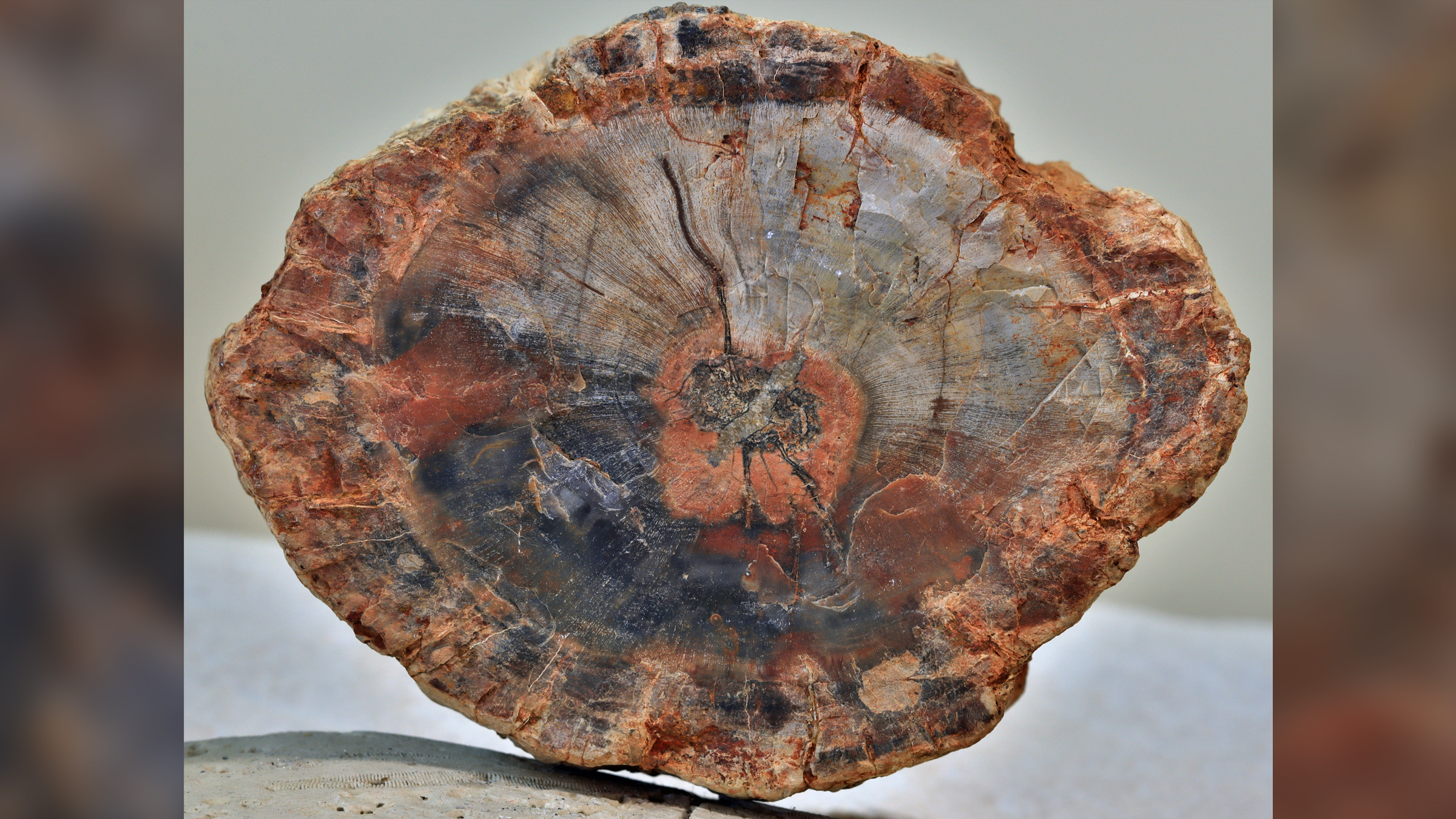
How long does it take to make petrified wood?
And what is it?

Petrified Forest National Park, in northeastern Arizona, is known for — and named in honor of — its extensive deposits of petrified wood. So impressive and picturesque is the forest that it was used as the backdrop for the 1936 romantic thriller "The Petrified Forest," starring Bette Davis and Humphrey Bogart.
But what, exactly, is petrified wood? How is it made, and how long does it take to form?
"Petrified wood is essentially mineralized wood," David Sunderlin, a professor of geology who specializes in paleontology and paleoecology at Lafayette College in Pennsylvania, told Live Science in an email.
How does petrified wood form?
For wood to become petrified, it has to be buried quickly under mud, silt or volcanic ash before any rotting can set in. It needs to be buried within this sediment for an extended period of time — usually, millions of years — and if the ground in which the wood is buried is particularly well compacted, it won't be able to interact with oxygen or organisms, so will be unable to decay. In such instances, the organic material becomes fossilized. During this process, known as mineralization, groundwater rich in minerals flows through the sediment and the dead tree, whose woody remains are replaced over time by the water's minerals. In the case of petrified wood, these minerals tend to be silica, calcite, pyrite or another inorganic material, such as opal, according to the Quekett Microscopical Club, one of the world's oldest organizations dedicated to microscopy.
Related: When did Earth's first forests emerge?
So, although the material is called petrified "wood," it is actually not wood at all; rather, the minerals have replaced and taken on the appearance of the wood that was once there.
"The mineralization can be from either — or, much more often, both — mineral precipitation in or between the wood's cellular structures, or mineral replacement of the actual organic material that once made up the cell walls of the wood," Sunderlin said. "The former process is called permineralization, while the latter is simply called replacement."
Sign up for the Live Science daily newsletter now
Get the world’s most fascinating discoveries delivered straight to your inbox.
How long does it take for wood to become petrified?
"[It] can take a very long time on a human time-scale, but sometimes we see cases of amazingly quick wood preservation by these mineralization processes," Sunderlin said. "There are some incipient petrified wood pieces being formed in fallen logs in mineral hot springs, such as those at Yellowstone National Park. These accumulate substantial mineral deposits in their woody tissues year after year. Much of the petrified wood we see in the rock record, though, formed over longer timescales of thousands to millions of years and, sometimes, re-mineralization in multiple stages."
The exact amount of time needed for wood to become petrified depends on the conditions — the main one being how rich the groundwater is in minerals such as silica — but generally ranges from hundreds of thousands of years to millions of years.
Where does petrified wood form?
Those long timescales mean petrified wood forms better in some environments and locations than in others.
"Many of the world's most famous petrified wood localities are in exposed sedimentary rocks that were deposited in fluvial-lacustrine paleoenvironmental conditions," Sunderlin said. These are areas that were once ancient floodplains or lake systems where low dissolved oxygen levels prevented microbial decay. Once the wood was buried in these locations, groundwater supplied the sediments needed to petrify the wood and eventually remove all of the tree's original organic matter.
"We have petrified wood in the fossil record in these and other paleoenvironmental settings ever since the Devonian Period, more than 350 million years ago," Sunderlin said.
So, what about petrified wood's scientific value? Can studying it provide any valuable insights?
"Much like the study of growth rings in modern wood, petrified wood can be very useful in learning about the growing conditions a tree experienced in the ancient past," Sunderlin said. "When the preservation is right, petrified wood can tell of ecological and climatological conditions of an environment long ago."
Scientists can look for signatures of abundant rainfall or drought reflected in characteristics of the wood rings and may even be able to spot evidence of wildfires or insect infestation, Sunderlin said. In some cases, wood anatomy is so well preserved that, by comparing it to modern examples, researchers can learn more about "particular aspects of that lineage's evolution, biogeography, and ecology," he added.
While it tends to take millions of years for petrified wood to form in the natural world, scientists have found ways to replicate the necessary processes in the lab and can now artificially create petrified wood in days.
As Live Science reported back in 2005, scientists at the Pacific Northwest National Laboratory (PNNL) recreated, under laboratory conditions, the conversion of wood into a ceramic. The process involved cutting the wood into small cubes, soaking the pieces in hydrochloric acid for two days, and then submerging them in silica solution for another two days. Once air-dried, the pieces were placed into a furnace filled with argon gas, heated to about 1,550 degrees Fahrenheit (1,400 degrees Celsius) and baked for two hours.
According to a PNNL statement celebrating the results, "[the] method yields an identical, positive reproduction of the wood."
Originally published on Live Science on Nov. 30, 2012 and rewritten on July 20, 2022.

Joe Phelan is a journalist based in London. His work has appeared in VICE, National Geographic, World Soccer and The Blizzard, and has been a guest on Times Radio. He is drawn to the weird, wonderful and under examined, as well as anything related to life in the Arctic Circle. He holds a bachelor's degree in journalism from the University of Chester.










